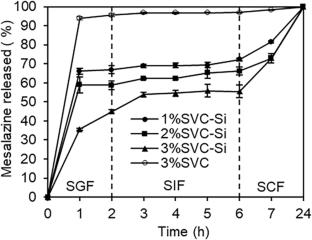Aim of this work is to study the effect of pectin content on the physicochemical, morphological, swelling and releasing properties of composite hydrogel beads based on pectin and sodium metasilicate (SM). Synthesis of pectin–silica composite beads was carried out using the ionotropic gelation method and sol–gel reaction of SM as a silica precursor. The entrapment efficiency of mesalazine (66–88%) and gel strength (0.86–2.10 N) increased in the pectin–silica hydrogels compared to pectin–Ca hydrogels. These parameters increased with the increase in concentration of pectin. Energy-dispersive X-ray analysis showed that the silicon content was higher in the beads with an increased SM/pectin ratio (2:1). Fourier transform infrared spectroscopy revealed the formation of an organic/inorganic composite, the presence of H–bonds in pectin–silica hydrogel and the loading of mesalazine into the composite gel. Composite hydrogels with the lowest amount of pectin (an organic component) showed the highest thermal stability. Pectin–silica hydrogels were less sensitive to the adsorption of gastrointestinal fluids and released mesalazine very slowly compared to pectin–Ca gels. Mesalazine release from composite gels decreased with the increase in pectin concentration and gel strength. The gel formulations with high gel strength and a low SM/pectin ratio had the lowest mesalazine release rate in the gastrointestinal environment. Mesalazine was released slowly in gastrointestinal fluids and more rapidly in colonic fluid. Synthesized pectin–silica hydrogels based on callus culture pectin, appear to be a promising composite system for targeted drug delivery to the colon.



